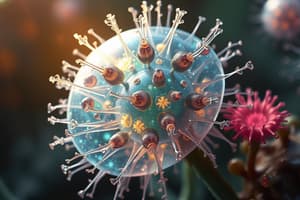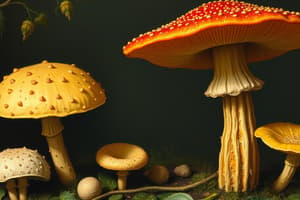Podcast
Questions and Answers
What is the primary function of holdfast in multicellular organisms like kelp?
What is the primary function of holdfast in multicellular organisms like kelp?
- Support and anchorage (correct)
- Photosynthesis
- Nutrient absorption
- Reproduction
Which of the following describes how fucus reproduces?
Which of the following describes how fucus reproduces?
- Produces only male gametes
- Produces male and female gametes in separate chambers (correct)
- Produces both male and female gametes in the same chamber
- Reproduces asexually through fragmentation
What type of organism is referred to as a keystone species in a kelp forest?
What type of organism is referred to as a keystone species in a kelp forest?
- Species that are limited to deep ocean zones
- Predators that eat kelp directly
- Organisms that provide habitat for many animals (correct)
- Organisms with no role in the ecosystem
What characteristic distinguishes saprobic organisms?
What characteristic distinguishes saprobic organisms?
Which of the following best describes the structure of foraminifera?
Which of the following best describes the structure of foraminifera?
Which disease is caused by members of the genus that also produces cotton wool disease in fish?
Which disease is caused by members of the genus that also produces cotton wool disease in fish?
What role do pseudopods play in foraminifera?
What role do pseudopods play in foraminifera?
Which nutrient source do chemoheterotrophic organisms primarily rely on?
Which nutrient source do chemoheterotrophic organisms primarily rely on?
What type of organisms do protists primarily consist of?
What type of organisms do protists primarily consist of?
What term describes the movement of organisms toward or away from light?
What term describes the movement of organisms toward or away from light?
How do pseudopodia contribute to the movement of certain protists?
How do pseudopodia contribute to the movement of certain protists?
What is the resting state of plasmodial slime molds called when conditions are poor?
What is the resting state of plasmodial slime molds called when conditions are poor?
Which characteristic do plasmodial slime molds share with fungi?
Which characteristic do plasmodial slime molds share with fungi?
Which type of movement is associated with responsiveness to a chemical gradient?
Which type of movement is associated with responsiveness to a chemical gradient?
Which of the following is NOT a function of cilia in protists?
Which of the following is NOT a function of cilia in protists?
What describes a sessile organism's behavior?
What describes a sessile organism's behavior?
What is the primary method by which Paramecium moves?
What is the primary method by which Paramecium moves?
What metabolic strategy do some protists exhibit in varying environmental conditions?
What metabolic strategy do some protists exhibit in varying environmental conditions?
Which organism is primarily responsible for breaking down cellulose in termite digestive tracts?
Which organism is primarily responsible for breaking down cellulose in termite digestive tracts?
Which of the following organisms is NOT pathogenic?
Which of the following organisms is NOT pathogenic?
What is the main characteristic feature of the supergroup Excavates?
What is the main characteristic feature of the supergroup Excavates?
What defines multicellular brown algae such as Fucus?
What defines multicellular brown algae such as Fucus?
Which of the following best describes the nutritional needs of green flagellated protists?
Which of the following best describes the nutritional needs of green flagellated protists?
What is a unique characteristic of organisms from the supergroup Alveolates?
What is a unique characteristic of organisms from the supergroup Alveolates?
Study Notes
Protists
- Single-celled or multicellular organisms
- Resemble both plants and animals
- Mostly eukaryotic
- Can have microtubules which form the cytoskeleton for support
- Can move via cilia, flagella, or pseudopodia
Locomotion
- Protists can move to achieve favorable conditions
- Phototaxis: Movement towards or away from light
- Chemotaxis: Movement in response to a chemical gradient
- Thigmotaxis: Movement in response to touch
Plasmodial Slime Mold
- A giant single-celled organism with multiple nuclei
- Macroscopic, can be seen with the naked eye
- Shares characteristics with fungi
- Moves via pseudopods, can extend them to explore the environment
- Can move towards or away from chemicals based on their needs
- Forms a resting state called a sclerotinum in unfavorable conditions
- Exhibits complex decision-making including identifying optimal pathways to food
Paramecium
- Large single-celled organism with cilia
- Has an oral groove with a pore called the cytostome for taking in food
- Heterotrophic, needs to obtain food from outside sources
- Not pathogenic, unlike most protists
Euglena
- Flagellated, unicellular organism that lives in water
- Has chloroplasts allowing for photosynthesis
- Can be heterotrophic when light is scarce or autotrophic in favorable conditions.
- Facultative means able to switch between different metabolic modes
Trichonympha
- Unicellular, flagellated organism
- Endosymbionts of termites, meaning they live within termites in a mutually beneficial relationship
- Live in the termites' digestive tracts and produce enzymes called cellulases to break down cellulose in wood
- Lack mitochondria, but contain other endosymbionts that produce cellulases
- Some members of this supergroup cause human diseases
Fucus
- Sessile, multicellular organism
- Brown algae also known as kelp, distinct from plants
- Has specialized structures:
- Fronds: Leaves
- Stipe: Stem
- Holdfast: Roots
- Photosynthetic and grow in shallow marine areas, forming kelp forests that provide habitats for other organisms
- Produces both male and female gametes in separate chambers
- Used as an emulsifier and dietary supplement, also relevant for treating diseases
- Kelp is a keystone species, many organisms in the kelp forest rely on it for survival
Water Mold
- Chemoheterotrophic saprobic, grows on dead things and in water
- Body is a mass of thread-like filaments called hyphae, a term used for fungi
- Coenocytic, lacks internal cell membranes like Physarum
- Produces male and female gametes
- Causes various plant and animal diseases, including: - Cotton wool disease on fish - Late blight, which caused the Irish potato famine
Foraminifera
- Moves via pseudopods
- Chemoheterotrophic marine organisms
- Biomineralized with calcium carbonate
- Foraminifera uses calcium carbonate to build shells called tests
- These shells contribute to the formation of deep-sea limestone
Studying That Suits You
Use AI to generate personalized quizzes and flashcards to suit your learning preferences.
Related Documents
Description
This quiz explores the fascinating world of protists, focusing on their structure, locomotion methods, and specific examples such as plasmodial slime mold and paramecium. Understand the unique characteristics that allow these organisms to thrive and adapt in various environments.




